Category: Patients
A 12-year-old show jumper is moving nicely just 2 months after laboring to walk.
Palm Beach Equine Clinic Staff Surgeon Dr. Weston Davis operated on a severe lameness case on July 5 that had quickly progressed into an emergency situation.
Evaluation and Diagnosis
Annabelle was referred to Palm Beach Equine Clinic for advanced imaging and evaluation of severe subsolar abscessation in the Holsteiner mare’s left front foot that was not responding to aggressive therapies.
She was diagnosed with infectious pedal osteitis in the left fore and early stages of support limb laminitis in the right fore. Pedal osteitis is an infection of the coffin bone. Annabelle previously showed in the Adult Jumpers with her owner, Jennifer Knobel, but the infection had advanced to the point that she could barely walk.
Local veterinarian Dr. Kim Snyder vigorously managed Anabelle’s foot condition in the field before referring the case to Palm Beach Equine Clinic. She performed digital radiographs at the farm, but they failed to adequately define the lesion. She requested an MRI study of the foot to more accurately image the underlying causes of the persistent foot abscess, such as a foreign body, bone infection, sequestrum, or tumor.
Advanced Medical Imaging Technology
 As the radiographs were not definitive enough alone, the team at Palm Beach Equine Clinic used their state-of-the-art MRI technology for a more detailed analysis. The MRI showed excess fluid and severe inflammation within the coffin bone. The infectious pedal osteitis had caused the bottom of the coffin bone to begin to deteriorate. Worsening the situation, Annabelle was reluctant to bear weight on her left foot. Then she developed mild laminitis in her right foot due to the increased load on the supporting limb to relieve pressure. The development of support limb laminitis determined the emergency status of the left fore lameness as laminitis could be a fatal complication.
As the radiographs were not definitive enough alone, the team at Palm Beach Equine Clinic used their state-of-the-art MRI technology for a more detailed analysis. The MRI showed excess fluid and severe inflammation within the coffin bone. The infectious pedal osteitis had caused the bottom of the coffin bone to begin to deteriorate. Worsening the situation, Annabelle was reluctant to bear weight on her left foot. Then she developed mild laminitis in her right foot due to the increased load on the supporting limb to relieve pressure. The development of support limb laminitis determined the emergency status of the left fore lameness as laminitis could be a fatal complication.
Dr. Davis and the team at Palm Beach Equine Clinic took immediate action using the MRI scans for accurate surgical mapping. The MRI study documented exactly where the infectious pedal osteitis was located. This mapped position was used in comparison to the previously taken radiographs. Both imaging modalities were used intra-operatively to guide Dr. Davis precisely to the area of infected bone.
Surgery and Recovery
Annabelle was placed under general anesthesia, and the left front limb was prepared for surgery. A 5 cm long x 3 cm wide window was cut through the sole down to the surface of the coffin bone, through which the necrotic (infected) bony tissue was removed. Prior to recovery, the surgical site was packed with antibiotic powder and a full distal limb bandage was applied. Additional support of Soft-Ride boots and sole supports were positioned. Medical grade maggots were applied to the foot the day after surgery to safeguard absolute full debridement of all necrotic/infected tissues.
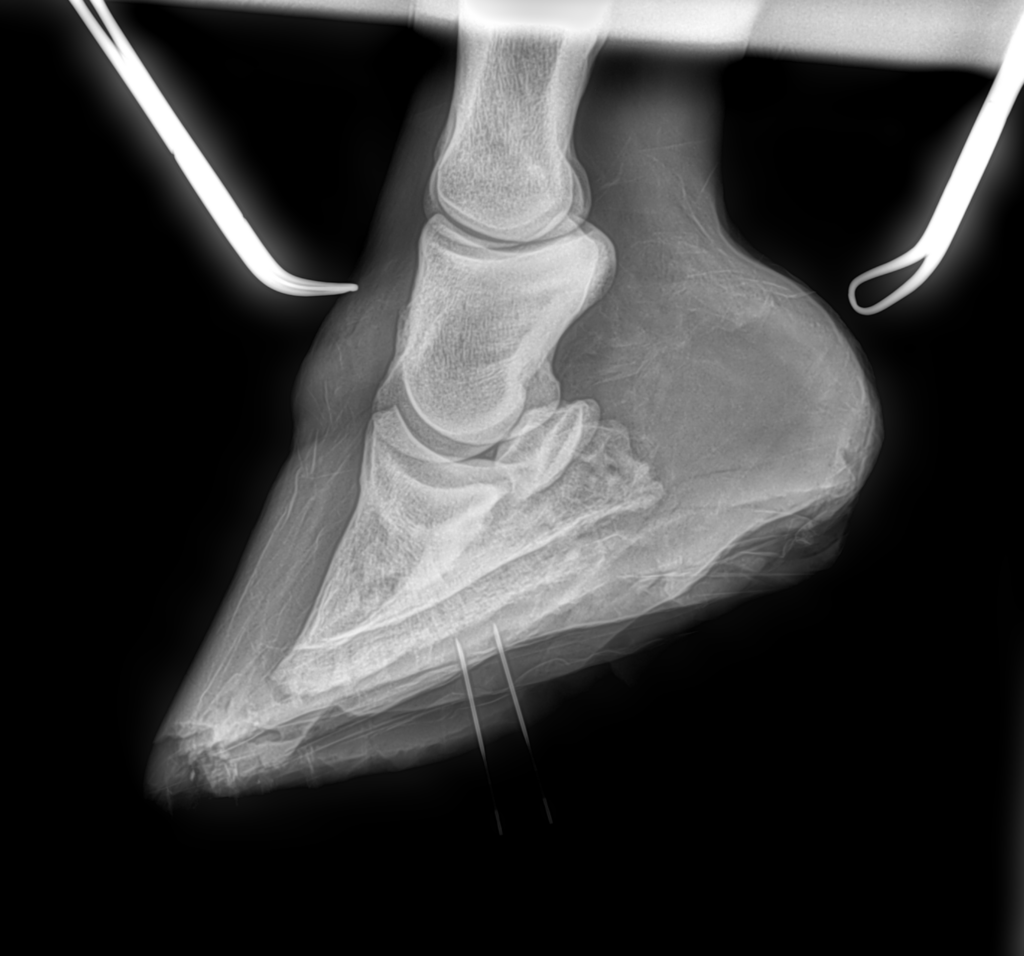
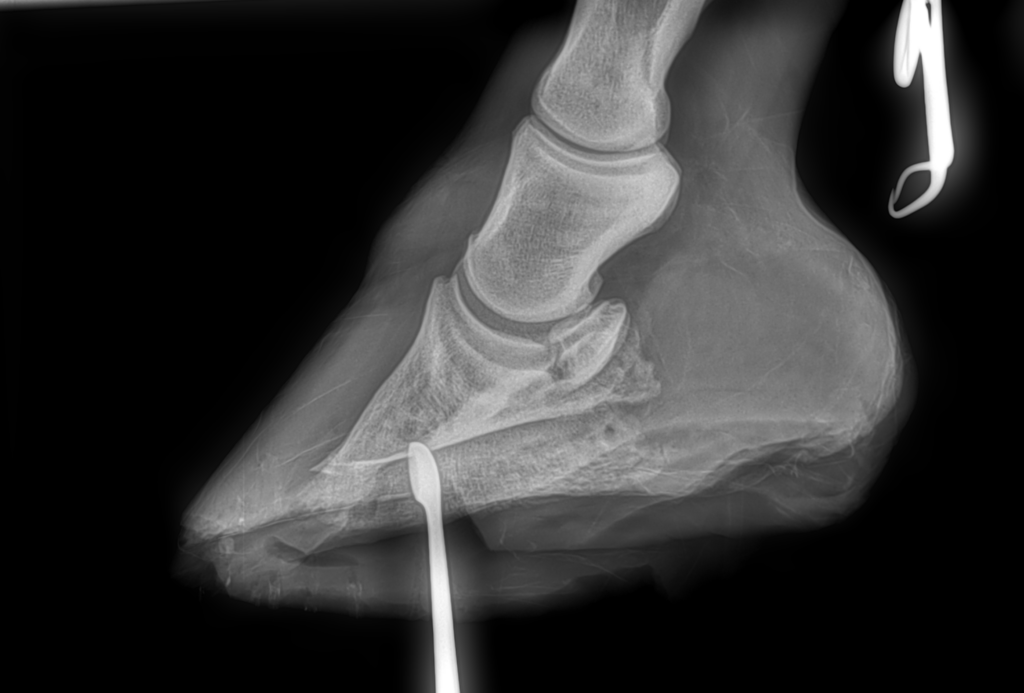
 Annabelle was placed on a range of antibiotics. Pain was managed with local nerve blocks and anti-inflammatory medications. Her pain improved rapidly in the operated left limb and signs of laminitis in the right fore resolved as well. During her stall rest recovery, the foot was soaked routinely in Epsom salts. Betadine soaked gauze was applied over the frog and surgery site each day and the hoof was wrapped for protection.
Annabelle was placed on a range of antibiotics. Pain was managed with local nerve blocks and anti-inflammatory medications. Her pain improved rapidly in the operated left limb and signs of laminitis in the right fore resolved as well. During her stall rest recovery, the foot was soaked routinely in Epsom salts. Betadine soaked gauze was applied over the frog and surgery site each day and the hoof was wrapped for protection.
Snyder continued to care for Annabelle in the post-op period. Synder’s husband and farrier, Jim Gilchrist, applied a shoe with a treatment plate to protect the bottom of the foot. This allowed for routine access by removal of three simple screws.
The initial cause of the abscess or why the infectious pedal osteitis progressed so aggressively is still unclear. Dr. Davis speculates that it was possibly a spontaneous abscess and for whatever reason, whether the depth into the foot or the presence of a highly infectious bacteria, Annabelle was just unlucky. Instead of draining like a “normal” abscess, this particular case established an infection within the bone. This made it impossible to clear the infection with even the most aggressive medical therapies apart from surgical removal.
 Annabelle’s infectious pedal osteitis has cleared and her hoof is healing well. Now she is walking sound and has a favorable prognosis for further improvement with hopes of eventually return to work.
Annabelle’s infectious pedal osteitis has cleared and her hoof is healing well. Now she is walking sound and has a favorable prognosis for further improvement with hopes of eventually return to work.
Thoroughbred Brazilian Triple Crown winner Bal a Bali was admitted to Palm Beach Equine Clinic on August 3, 2014. The elite athlete was treated for life-threatening laminitis by board-certified surgeon Dr. Weston Davis of Palm Beach Equine Clinic, in conjunction with Dr. Vernon Dryden, just months after his Triple Crown win in March of that year.
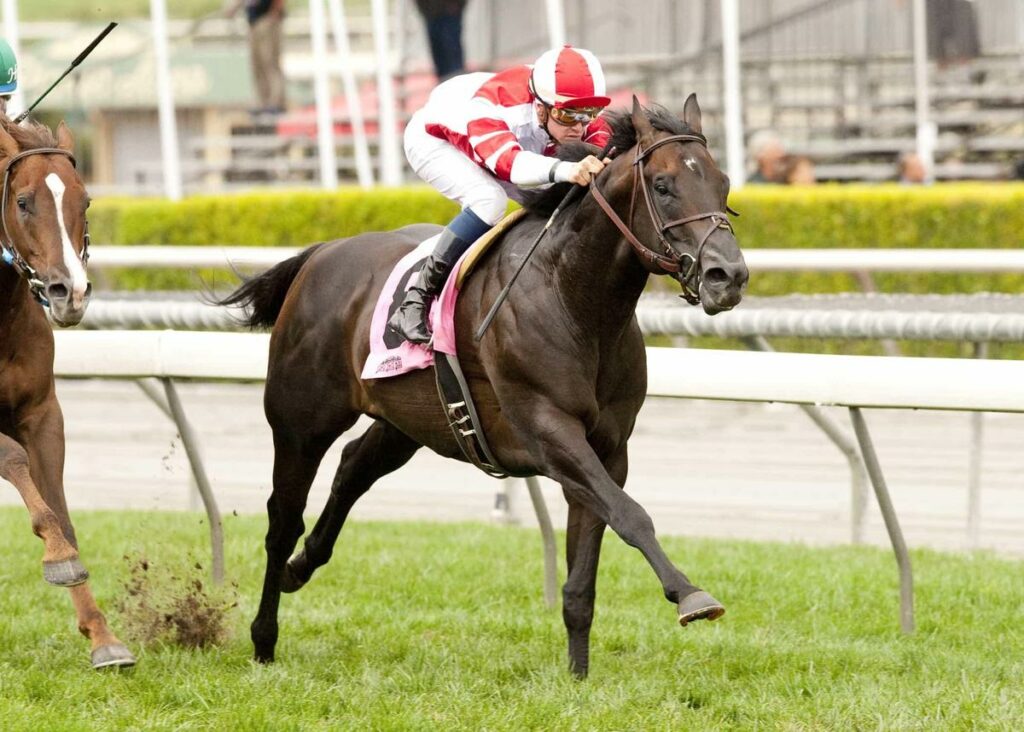
Brazil’s 2014 Horse of the Year, Bal a Bali (Put It Back—In My Side, by Clackson) took an impressive win in the Grande Premio Cruzeiro do Sul (Brz-I) to become the country’s 12th Triple Crown winner. He finished the race in track-record time at Gavea racecourse.
Following his last start in June 2014, Bal a Bali was purchased by Fox Hill Farm and Siena Farm and imported to the U.S. in late summer, but unfortunately suffered from laminitis brought on during his travels. Bal a Bali was in a Florida quarantine center scheduled to fly to trainer Richard Mandella’s stable in California when the problems developed.
Bal a Bali Admitted to PBEC Equine Hospital
Bal a Bali was quickly moved to Palm Beach Equine Clinic in Wellington, Florida, where he was received by Dr. Weston Davis, who would oversee his care in the equine hospital for the next three months. Palm Beach Equine Clinic set aside an entire section of the hospital barn as a quarantine unit to meet the horse’s final import requirements while he was treated with aggressive cryotherapy – a gold standard of laminitis care. Hospital staff carefully monitored Bal a Bali and treated him with consistent cold-water spa treatments for several days throughout the severe acute phase of this disease. He was gradually weaned out of the spa as he improved clinically.
On two occasions, Dr. Davis performed intravenous regional perfusions of the horse’s feet with advanced stem cell treatments. A myriad of other medical therapies were administered throughout his stay. The progression of his laminitis was closely monitored with the use of diagnostic imaging and meticulous farrier care. Farriery care included ensuring optimal sole support and proper mechanics to decrease strain on the fragile lamina. By October, the horse was cleared to travel to Siena Farm in Kentucky. There, Dr. Dryden continued to treat the horse and he was then flown to California in January.
Winning his Battle with Laminitis
After a nine-month recovery process, Bal a Bali made a miraculous return to the track for his North American debut in May 2015. He cruised to victory in the $100,000 American (G3), a one-mile turf race for three-year-olds and up at Santa Anita Park. At that point, the five-year-old had captured 12 of 13 career starts and earned $570,078.
Bal a Bali’s comeback was no doubt a result of the outstanding care he received at Palm Beach Equine Clinic under the extraordinary supervision of Dr. Weston Davis and Dr. Vernon Dryden.
Thank you Fox Hill Farm and Siena Farm for the trust you placed in Palm Beach Equine Clinic.
Nelson Pessoa’s Miracle Horse: Artemide d’Ecaussinnes
By Jennifer Wood Media, Inc.
Owning a horse comes with a degree of uncertainty and worry. If your horse has a traumatic accident, sometimes the very best you can hope for are swift care and an eventual recovery. For show jumping legend Nelson Pessoa, seeing his horse Artemide d’Ecaussinnes with a severe trauma in the ring was a shock. But what came afterward surprised him even more.
Pessoa purchased Artemide d’Ecaussinnes, an eight-year-old BWP gelding, at the beginning of the year. The young horse showed at the FTI WEF with Pessoa’s rider, Stephan Barcha, and another junior rider, Joao Victor Castro. “It’s a horse that shows a lot of promise, to be a nice horse for speed classes or a junior horse. It’s a horse with a wonderful character,” Pessoa said.
Artemide’s trajectory changed in the blink of an eye on Friday, January 31, in the DeNemethy Ring in a 1.40m class. With Castro riding, the pair had a miscommunication at an oxer and landed on the standard. In a freak accident, the wood sheared from the attached metal strip holding the jump cup, which then went into the horse’s stomach. Luckily, horsemen on the side of the ring and the jump crew reacted quickly to be at the horse’s side, and the horse’s groom, Waldeci da Silva ran from the in-gate to help keep Artemide’s organs inside his body. In the gruesome accident, it was the quick thinking of these individuals that helped save his life.
“It was just really bad luck, it wasn’t anybody’s fault,” Pessoa recalled. “The horse was looked after really quickly. The staff from the show grounds was really good. They made the necessary decisions to help him.”
Those helping in the ring had the unenviable job of holding Artemide’s intestines to keep a bad situation from turning worse. Dr. Hilary Clayton was there shortly to start bandaging the horse, and Palm Beach Equine Clinic was quick to react as well, bringing the equine ambulance in immediately to transport Artemide less than a mile away to Palm Beach Equine Clinic (PBEC), where he went into surgery with no delay. All in all, only 30 minutes elapsed from the time of the accident to when Artemide went into emergency surgery.
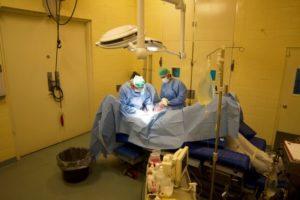
The surgery was led by Dr. Robert Brusie and Dr. Weston Davis of PBEC, which has three Board Certified surgeons. Dr. Brusie praised the quick thinking of fellow competitors, the DeNemethy Ring jump crew Rafael Rios, Cesar Morales, and Steven Sarmiento, as well as da Silva.
“I called (horse show manager) David Burton and told him his people did a fantastic job keeping (the horse) quiet. That injury is really painful, with intestines out of his abdomen. The horse was panicky all the way over here until we anesthetized him, with extreme pain. I was really pleased with the way everything worked. We rehearse these kinds of things, (but) we mainly have fractures, ruptured tendons, as injuries. We do have drills before the season with the ambulance driver. It paid off. Nothing was a surprise, and nobody wondered what to do next. It’s being ready and prepared.”
When Dr. Brusie and Dr. Davis performed the surgery, they were pleased to see that while it was a traumatic injury, there were no vital organs pierced and that the horse’s bowel only had a tear in the section outside of the horse’s abdomen. A second incision was made in the horse’s abdomen to help facilitate the surgery.
“We were really fortunate with that guy,” Dr. Brusie remembered. “We ended up taking out about two feet of intestine. He broke a couple of ribs too.”
“It was good luck for us that the (Palm Beach Equine) Clinic is very close,” Pessoa said. “Dr. Brusie did an unbelievable job.”
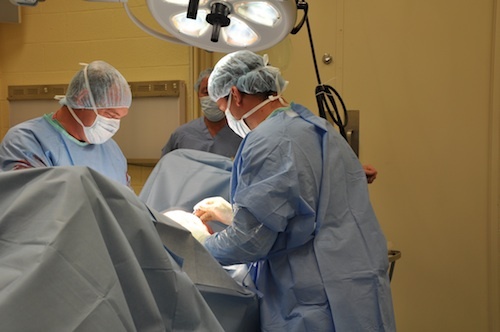
Artemide’s miraculous recovery is the combination of quick thinking and amazing care at Palm Beach Equine Clinic, but Pessoa believes the horse’s mindset is what solidified his chances of recovery. “One important point is that the horse is an unbelievable patient. Two hours after he was back in the stable, he wanted to eat and he was drinking. We were waiting for an infection or a temperature, but he had no temperature. It was like it was just a little cut. Twenty-four hours after the surgery, the horse was looking like nothing happened with him,” he explained. Dr. Brusie agreed, “It’s a really good temperament horse. It took a lot of courage for him to stand there and not thrash around. He’s a good horse.”
Artemide is currently getting back in shape by walking on a treadmill. Dr. Brusie compared his situation to colic surgery, where after 10 days recovering at PBEC, he went home, and he can be ridden again 30 days after surgery.
Pessoa expressed, “They said it was a miracle. I really want to say for everybody that has a horse here at this horse show, this clinic is something. You hope things like this won’t happen, but for sure with the number of horses and the amount of jumping here, things like that happen sometimes. It’s a great thing to have this support. People don’t always realize this – we realize now because it happened to us. I’m very grateful for them.”
Along with Drs. Brusie and Davis, Pessoa also gave thanks to Dr. Jorge Gomez and Dr. Selena Passante, his treating veterinarians, along with “the staff, the jump crew from the horse show, they saw the situation and helped save the horse.”
“We had no idea whose horse it was; we just had to save his life,” said Dr. Brusie. “This horse was meant to live. I was amazed neither one of those sites had any infection after we were done. It was meant to happen, and he was meant to live. It was a good feeling and a day when it was good to be a veterinarian.”